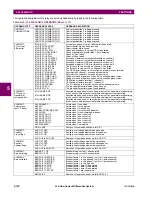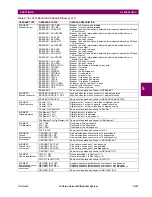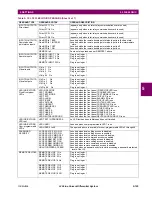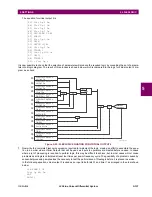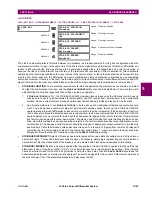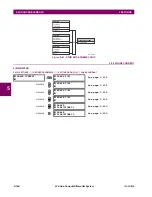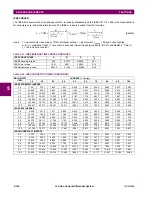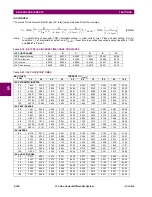
5-134
L30 Line Current Differential System
GE Multilin
5.5 FLEXLOGIC
5 SETTINGS
5
Figure 5–56: FLEXELEMENT SCHEME LOGIC
The
FLEXELEMENT 1 +IN
setting specifies the first (non-inverted) input to the FlexElement. Zero is assumed as the input if
this setting is set to “Off”. For proper operation of the element at least one input must be selected. Otherwise, the element
will not assert its output operands.
This
FLEXELEMENT 1 –IN
setting specifies the second (inverted) input to the FlexElement. Zero is assumed as the input if
this setting is set to “Off”. For proper operation of the element at least one input must be selected. Otherwise, the element
will not assert its output operands. This input should be used to invert the signal if needed for convenience, or to make the
element respond to a differential signal such as for a top-bottom oil temperature differential alarm. The element will not
operate if the two input signals are of different types, for example if one tries to use active power and phase angle to build
the effective operating signal.
The element responds directly to the differential signal if the
FLEXELEMENT 1 INPUT MODE
setting is set to “Signed”. The ele-
ment responds to the absolute value of the differential signal if this setting is set to “Absolute”. Sample applications for the
“Absolute” setting include monitoring the angular difference between two phasors with a symmetrical limit angle in both
directions; monitoring power regardless of its direction, or monitoring a trend regardless of whether the signal increases of
decreases.
The element responds directly to its operating signal – as defined by the
FLEXELEMENT 1 +IN
,
FLEXELEMENT 1 –IN
and
FLEX-
ELEMENT 1 INPUT MODE
settings – if the
FLEXELEMENT 1 COMP MODE
setting is set to “Level”. The element responds to the
rate of change of its operating signal if the
FLEXELEMENT 1 COMP MODE
setting is set to “Delta”. In this case the
FLEXELE-
MENT 1 dt UNIT
and
FLEXELEMENT 1 dt
settings specify how the rate of change is derived.
The
FLEXELEMENT 1 DIRECTION
setting enables the relay to respond to either high or low values of the operating signal. The
following figure explains the application of the
FLEXELEMENT 1 DIRECTION
,
FLEXELEMENT 1 PICKUP
and
FLEXELEMENT 1 HYS-
TERESIS
settings.
842004A3.CDR
FLEXELEMENT 1
FUNCTION:
SETTING
Enabled = 1
SETTINGS
FLEXELEMENT 1 INPUT
MODE:
FLEXELEMENT 1 COMP
MODE:
FLEXELEMENT 1
DIRECTION:
FLEXELEMENT 1 PICKUP:
FLEXELEMENT 1 dt UNIT:
FLEXELEMENT 1 dt:
RUN
FLEXELEMENT 1 +IN:
SETTINGS
Actual Value
FLEXLOGIC OPERANDS
FxE 1 DPO
FxE 1 OP
FxE 1 PKP
FLEXELEMENT 1 -IN:
Actual Value
+
-
FlexElement 1 OpSig
ACTUAL VALUE
Disabled = 0
FLEXELEMENT 1 BLK:
SETTING
Off = 0
AND
t
PKP
t
RST
SETTINGS
FLEXELEMENT 1 RST
DELAY:
FLEXELEMENT 1 PKP
DELAY:
FLEXELEMENT 1 INPUT
HYSTERESIS:
Summary of Contents for L30
Page 10: ...x L30 Line Current Differential System GE Multilin TABLE OF CONTENTS ...
Page 30: ...1 20 L30 Line Current Differential System GE Multilin 1 5 USING THE RELAY 1 GETTING STARTED 1 ...
Page 370: ...5 244 L30 Line Current Differential System GE Multilin 5 10 TESTING 5 SETTINGS 5 ...
Page 464: ...A 10 L30 Line Current Differential System GE Multilin A 1 PARAMETER LISTS APPENDIX A A ...
Page 600: ...C 30 L30 Line Current Differential System GE Multilin C 7 LOGICAL NODES APPENDIX C C ...
Page 610: ...D 10 L30 Line Current Differential System GE Multilin D 1 IEC 60870 5 104 APPENDIX D D ...
Page 622: ...E 12 L30 Line Current Differential System GE Multilin E 2 DNP POINT LISTS APPENDIX E E ...
Page 634: ...F 12 L30 Line Current Differential System GE Multilin F 3 WARRANTY APPENDIX F F ...
Page 644: ...x L30 Line Current Differential System GE Multilin INDEX ...

